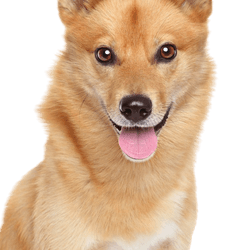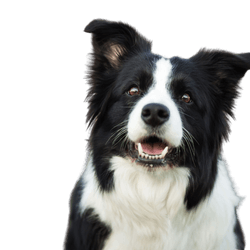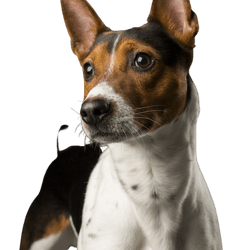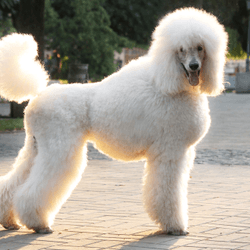
Clumber Spaniel Breed description: Character & Co
Clumber Spaniel
Facts & Origin
Clumber Spaniel - Breed description
Ancestry and origin
The origin of the breed is not clear. However, it is very likely that it originated in France in the 18th century. From this time documents exist, which prove that the French Duke of Nouailles gave some dogs to the English Duke of Newcastle, with which he started a breeding at his residence Clumber Park. This is where the name Clumber Spaniel comes from. For many decades, the breed was a popular hunting companion of the nobility. They used the dog for duck and pheasant hunting. In 1872, the breed was recognized by the British Kennel Club, and only much later, in 1954, by the Fédération Cynologique International (FCI). The Clumber Spaniel is still today a retriever and water dog. But it is also suitable as a family dog.
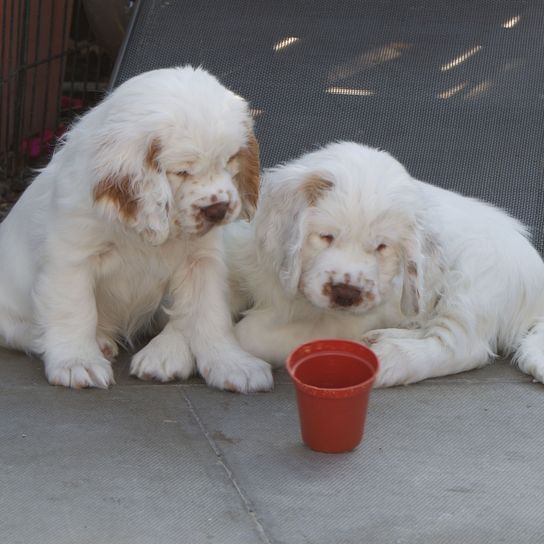


| Alternate Name | - |
| Origin | UK |
| Life expectancy | 10 - 14 years |
| Care requirements | high-maintenance |
| Activity level | average |
| FCI group | Flushing Dogs |
| AKC group | not recognised |
| KC group | not recognised |
Attitude, character and temperament of the breed
Breed characteristics and temperament
The Clumber Spaniel is kept in FCI Group 8 (Retrievers - Water Dogs), Section 2 (Retrievers), Standard No. 109, with working test. The dogs have a calm, somewhat stoic temperament. They radiate calmness, composure, level-headedness, but also primitive strength. The essential character traits of this breed can be described as follows:
- intelligent
- patient
- friendly
- reserved
- willing to work
Attitude and education
Nothing can shake or upset these dogs. They are extremely strong nerves and not a bit aggressive. They react to new situations thoughtfully and level-headedly. Kept as a family dog, they are usually fixated on one person, but at the same time they are a good protector and tireless playmate for the children. Towards strangers he usually behaves indifferently. Also four-legged conspecifics do not cause him any difficulties. Nevertheless, the education of the dogs is not quite easy and belongs in the hands of dog owners with some experience. This is due to the fact that the Clumber Spaniel has a very thick head and can be extremely stubborn. However, with consistency and loving patience, obedience can be taught to this intelligent breed. As an original hunting dog, he definitely needs a lot of exercise in nature. Tip: The Clumber Spaniel is an ideal companion for hiking holidays.
Character
Usage

Health and breeding information
Care and nutrition
The care expenditure is relatively high. The dense coat must be brushed well every day, otherwise it will become matted. The ears must also be brushed carefully and cleaned regularly. The food should contain a high proportion of meat, but no cereals. Two balanced food rations a day are sufficient. The dogs are relatively voracious eaters and tend to be overweight. Therefore, when giving treats, restraint is advised and regular weight checks are recommended.
Health and life expectancy
Typical diseases of the breed are eye diseases, hip dysplasia and slipped discs. As always, however, good genes through appropriate breeding selection are the best safeguard. The dogs can live up to 14 years in good health.
Worth knowing
The dogs have an increased allergy potential. The Clumber Spaniel also has some negative traits - it snores and drools quite a bit. If you still want one of these dogs, you'll have to do some searching, as the dogs are rare and breeders are few and far between. VDH member clubs, such as the Jagdspaniel-club, or the Spaniel-club-deutschland canbe helpful in your search. Good luck with the search!


Breed characteristics and appearance
The Clumber Spaniel is a heavy, massively built dog with a square head. They have a medium height at the withers of about 40 to 45 cm. Male dogs can weigh up to 29.5-34 kg. Bitches are somewhat lighter at 25-29.5 kg. The coat of the dogs is of silky and smooth texture. The coat colour is white with lemon yellow markings. In the standard, orange markings are also permitted.
| Fur length | medium |
| Fur | wavy |
| Ear shape | Floppy Ear |
| Tail | fanned out |
| Anatomy | massive |
| Size ♀ | 40 - 45 cm |
| Weight ♀ | 25 - 29 kg |
| Size ♂ | 40 - 45 cm |
| Weight ♂ | 29 - 34 kg |
| Suitable For | - |
Colors



Known Diseases
Allergies
Can occur in a number of breeds, regardless of genetic makeup.
Eye diseases
Often occur with allergies and intolerances.
Disc problems
Herniated disc in dogs (discopathy). Herniated discs or dachshund paralysis cause dogs severe pain.
Hip dysplasia (HD)
The hip dysplasia or hip joint dysplasia of the dog (HD) is a maldevelopment of the hip joint.
Other medium dogs
Useful Articles
You can find articles that might interest you in the dogbible blog to match your favorite breed.
Visit our magazineto stay up to date on dog trends.
To find out more, view our Privacy Policy
Find here the breed that suits you and find out what character traits it has. Here you can also learn more about the origin, size and weight of your favorite breeds.
Matching your favorite breed, you'll find articles that might interest you on the dogbible dog blog.
How to recognise good canned food for the dog
Working dogs - a description of the use of dogs in professional life
Apps for dog owners - these 10 apps you should know about
Vacation with the dog at the sea: Is salt water dangerous for my treasure?
5 tips for a city trip with a dog - how to make it work so that everyone gets something out of it!





